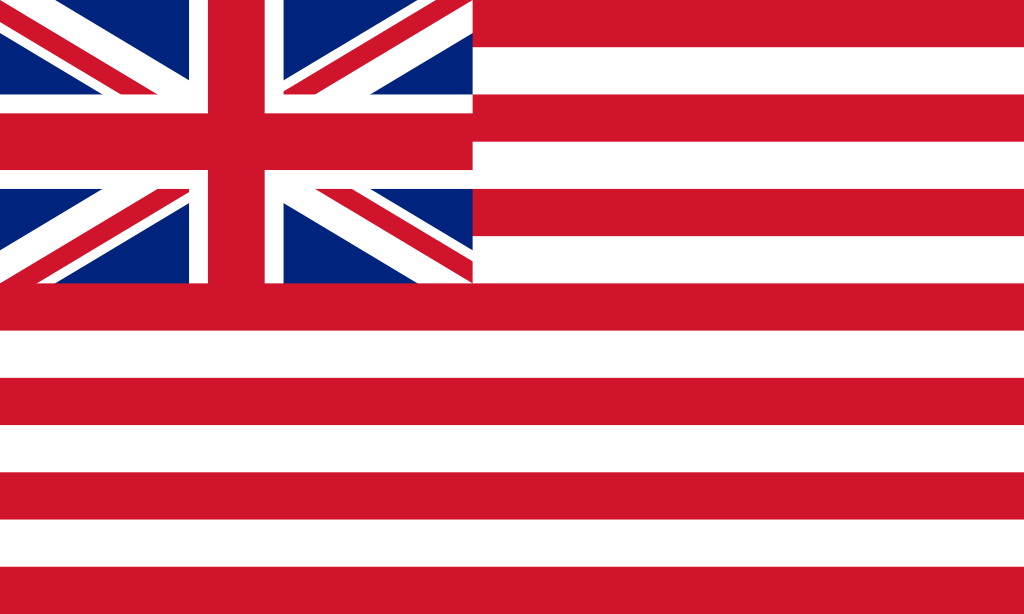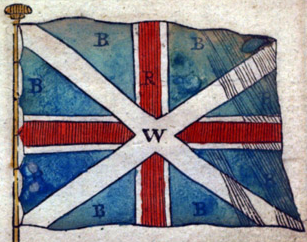Text from Wikipedia - the free encyclopaedia,
unless otherwise stated.

English: Flag of Hawaii.
Hawai`i: Ka hae Hawaiʻi.
Brezhoneg: Banniel Hawaii.
ᏣᎳᎩ: ᎭᏩᏱ ᎦᏓᏘ.
Deutsch: Flagge Hawaiis.
Español: Bandera de Hawái.
Français: Drapeau d'Hawaï.
This File: 3 September 2014.
User:: SiBr4.
(Wikimedia Commons)
The Flag of the State of Hawaii (Hawaiian: Ka Hae Hawaiʻi) is the official Standard symbolising Hawaii as a U.S. State. The same Flag had also previously been used by the Kingdom, Protectorate, Republic, and Territory of Hawaii.
It is the only U.S. State Flag to feature The Union Flag of The United Kingdom, a remnant of the period in Hawaiian history when it was associated with The British Empire.
The Hawaiian Islands (Hawaiian: Mokupuni o Hawai‘i) are an archipelago of eight major islands, several atolls, numerous smaller islets, and undersea sea-mounts in the North Pacific Ocean, extending some 1,500 miles (2,400 kilometers) from the island of Hawaiʻi, in the South, to Northernmost Kure Atoll.
Formerly, the Island Group was known to Europeans and Americans as "The Sandwich Islands",
a name chosen by Captain James Cook, in honour of the, then, First Lord of The Admiralty,
John Montagu, 4th Earl of Sandwich. The contemporary name is derived from the name of
the main island, Hawaii Island.
The Hawaiian Monarchy was overthrown in 1893 and The United States annexed the Islands in 1898. The U.S. State of Hawaii now occupies the archipelago almost in its entirety (including the uninhabited North-Western Hawaiian Islands), with the sole exception of Midway Island, which is, instead, an Unincorporated Territory within The United States Minor Outlying Islands.

The Flag of The British East India Company.
1801–1858.
Data from FOTW http://www.crwflags.com/fotw/flags/gb-eic.html.
This File: 13 March 2013.
User: Abjiklam.
(Wikimedia Commons)

English: The pre-1801 Union Flag (of Great Britain). Note the term "King's Colours". This is used by US-based flag makers and sellers because this was one of the flags used by The King's Forces during The American Revolutionary War. For more on this term see Flagstuff.com.
Español: Imperio Británico
Français: Drapeau du Royaume de Grande-Bretagne.
Date: 12 October 2005 (original upload date).
Source: Made by Hoshie
Sodipodi flag collection
(original file) Dead link as of: 4FEB2009.
Colours: vexilla mundi Dead link as of: 12DEC2007.
Author: Hoshie.
(Wikimedia Commons)

Hawaiian Islands (Sandwich Islands) Flag of 1868.
Johnson's new chart of national emblems, 1868.jpg [see, below]
Johnson's new chart of national emblems. Print showing the flags of various countries,
those flown by ships, and the "Signals for Pilots.".
In the top left corner is the "United States" 37-star flag, in the top right corner is the "Royal Standard of the United Kingdom Great Britain & Ireland"; in the bottom left corner is the "Russian Standard" and in the bottom right corner is the "French Standard." The flags on this sheet differ slightly from those on another sheet numbered 4 [top left] and 5 [top right].
Date: 1868.
Source: This file has been extracted from another file:
[see, below]
This image is available from the United States Library of Congress's
Prints and Photographs division under the digital ID pga.03872.
Author: Johnson, A. J. (Alvin Jewett), 1827-1884, publisher.
(Wikimedia Commons)

Johnson's new chart of national emblems (c. 1868).
Etching and engraving on paper ; on sheet 46×67.3 cm.
Original caption from loc.gov:
"Print showing the flags of various countries, those flown by ships, and the "Signals for Pilots." In the top left corner is the "United States" 37-star flag, in the top right corner is the "Royal Standard of the United Kingdom Great Britain & Ireland"; in the bottom left corner is the "Russian Standard" and in the bottom right corner is the "French Standard." The flags on this sheet differ slightly from those on another sheet numbered 4 [top left] and 5 [top right]."
Date: Circa 1868.
Source: Library of Congress Prints and Photographs Division Washington, D.C. 20540 USA http://hdl.loc.gov/loc.pnp/pp.print Reproduction Number: LC-DIG-pga-03872.
This image is available from the United States Library of Congress's
Prints and Photographs division under the digital ID pga.03872.
Author: Johnson, A. J. (Alvin Jewett), 1827-1884, publisher.
(Wikimedia Commons)

English: Flag of South Africa, used between 1928 and 1994.
Known as the "Oranje-Blanje-Blou".
[Editor: "Orange-White-Blue".]
From the xrmap flag collection 2.9.
Afrikaans: Die vlag van Suid-Afrika wat sedert 1928 tot en met 1994 in gebruik was. Die vlag staan bekend as die Oranje-Blanje-Blou.
Français: Le drapeau de l'Afrique du Sud entre 1928 et 1994, aussi appelé l'Oranje-Blanje-Blou.
Date: 1928-1994.
Source: SVG based on this image.
Author: Parliament of South Africa(Vector graphics image by Denelson83).
(Wikimedia Commons)

The three Flags, in the centre of the South African Flag (above),
representing the former British Colonies of Cape Colony and Natal,
with the Union Jack on the left,
followed by the Flags of the former Boer Republics of Orange Free State
and The South African Republic on the Right.
The Union Jack is shown with the hoist on the right.
The three small Flags from File:Flag of South Africa 1928-1994.svg
Source: Own work.
Author: Watchduck (a.k.a. Tilman Piesk).
(Wikimedia Commons)

The Grand Union Flag
of The United States of America.
Continental Colours.
Congress Flag.
Cambridge Flag.
First Navy Ensign.
Adopted: 3 December 1775 (unofficial).
Source: Own work.
(Wikimedia Commons)
The "Grand Union Flag" (also known as the "Continental Colours," the "Congress Flag,"
the "Cambridge Flag," and the "First Navy Ensign") is considered to be the first
National Flag of The United States of America – and, previously, that of
The United Colonies of North America – until 1777.
This Flag consisted of alternating thirteen Red and White Stripes with The British Union Flag ("Union Jack") – the variant prior to the inclusion of Saint Patrick's Cross for the 1801 unification of Ireland into The United Kingdom– in the canton.

Flag of the British Administration of Heligoland, 1807-1890.
Date: 28 August 2010.
Source: Own work.
Author: EJavanainen.
(Wikimedia Commons)
Heligoland (German: Helgoland; Heligolandic Frisian deät Lun ["the Land"])
is a small German archipelago in The North Sea.
The Heligoland Bight (part of The German Bight) in the South-Eastern corner of The North Sea.
These Islands are the only German Islands not in the immediate vicinity of the Mainland and are approximately three hours' sailing time from Cuxhaven, at the mouth of the River Elbe.
In addition to German, the local population, who are ethnic Frisians, speak the Heligolandic dialect of the North Frisian language, called Halunder. Heligoland was formerly called Heyligeland, or "Holy Land", possibly due to the Islands' long association with the god Forseti.
On 11 September 1807, during The Napoleonic Wars, HMS Carrier brought to
The Admiralty
Dispatches from Admiral Thomas McNamara Russell, announcing
Heligoland's capitulation to the British.
Heligoland then became a centre of
smuggling and espionage against Napoleon. Denmark formally ceded Heligoland
to King George III of The United Kingdom by The Treaty of Kiel
(14 January 1814).
Thousands of Germans came to Britain, via Heligoland, and joined The King's German Legion.
Prior to 1956, the Shipping Forecasts, on The Home Service (now Radio 4), would have included "Heligoland" as one of the "Sea Areas", e.g., "Humber, Dogger, Fisher, Heligoland". In 1956, it was changed to the now well-known "German Bight".

|
Heligoland Postage Stamp, depicting Queen Victoria, and denominated in Hamburg Schillings.
From 1875, its Postage Stamps were denominated in both Sterling and Gold Marks.
This File: 20 April 2007.
User: Dr. Blofeld.
(Wikipedia)

Unofficial Scottish Union Flag in the 1704 edition of
The Present State of the Universe.
Date: 1704.
Source: Transferred from en.wikipedia to Commons.
Author: Unknown.
(Wikimedia Commons)
In objecting to the design of The Union Flag adopted in 1606, whereby The Cross of Saint George surmounted that of Saint Andrew, a group of Scots took up the matter with John Erskine, 18th Earl of Mar, and were encouraged by him to send a Letter of Complaint to King James VI, via The Privy Council of Scotland, which stated that the Flag's design "will breid some heit and miscontentment betwix your Majesties subjectis, and it is to be feirit that some inconvenientis sail fall oute betwix thame, for our seyfaring men cannot be inducit to resave that flage as it is set down".
Although documents accompanying this complaint, which contained drafts for alternative designs, have been lost, evidence exists, at least on paper, of an unofficial Scottish variant, whereby The Scottish Cross was uppermost.
There is reason to think that Cloth Flags of this design were employed, during the 17th-Century,
for unofficial use on Scottish vessels at sea. This Flag's design is also described in the
1704 edition of "The Present State of the Universe", by John Beaumont, which contains,
as an appendix, The Ensigns, Colours or Flags of the Ships at Sea: Belonging to
The several Princes and States in the World.
A Welsh Dragon to sit on The Union Flag ?
Illustration: CREATIVE REVIEW
The following Text, dated 28 November 2007, is from CREATIVE REVIEW
Could this be the new British flag? In the U.K. Parliament, yesterday, Culture Minister, Margaret Hodge, pledged to consider a redesign of The Union Flag to incorporate The Welsh Dragon.
The Minister was responding to concerns raised by Welsh MPs, who claimed that their constituents' identity has been suppressed by the current design, which does not include a symbol to represent Wales. Albert Owen, Labour MP for Ynys Mon, was reported in The Guardian as claiming that: "We, in Wales, do not feel part of The Union Flag because The Dragon, or The Cross of Saint David, is not on it".
Since 1801, the British Flag has been made up of The Cross of Saint George (representing England)
The Cross of Saint George.
and The Cross of Saint Patrick (representing Ireland)
The Cross of Saint Patrick.
and The Cross of Saint Andrew, or "Saltire", (representing Scotland)
The Cross of Saint Andrew, or "Saltire".
And they're not happy.
If a new design were to follow the pattern of the previous one, it should use The Flag of the Patron Saint of Wales, Saint David.
If a new design were to follow the pattern of the previous one, it should use The Flag of the Patron Saint of Wales, Saint David.
But that looks like this.
So, The Dragon is being proposed as a compromise.
The design of the current Flag, incorporating three different Flags, had been "a challenge," said Hodge. "Thinking of a new design, that would meet everyone's aspiration, would be an even greater challenge."
The Cross of Saint David.
So, The Dragon is being proposed as a compromise.
The design of the current Flag, incorporating three different Flags, had been "a challenge," said Hodge. "Thinking of a new design, that would meet everyone's aspiration, would be an even greater challenge."
You can say that again.

No comments:
Post a Comment